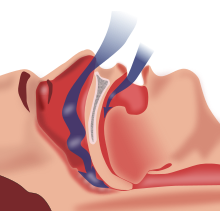User:Mr. Ibrahem/Sleep apnea
| Sleep apnea | |
|---|---|
| Other names | Sleep apnoea, sleep apnea syndrome |
 | |
| Obstructive sleep apnea | |
| Pronunciation | |
| Specialty | Otorhinolaryngology, sleep medicine |
| Symptoms | Pauses in breathing or periods of shallow breathing during sleep, snoring, tired during the day[1][2] |
| Complications | Heart attack, stroke, diabetes, heart failure, irregular heartbeat, obesity, motor vehicle collisions[1] |
| Usual onset | 55–60 years old[1][3] |
| Types | Obstructive sleep apnea (OSA), central sleep apnea (CSA), mixed sleep apnea[1] |
| Risk factors | Overweight, family history, allergies, enlarged tonsils[4] |
| Diagnostic method | Overnight sleep study[5] |
| Treatment | Lifestyle changes, mouthpieces, breathing devices, surgery[1] |
| Frequency | 1–6% (adults), 2% (children)[3][6] |
Sleep apnea is a sleep disorder in which pauses in breathing or periods of shallow breathing during sleep occur more often than normal.[1] Each pause can last for a few seconds to a few minutes and they happen many times a night.[1] In the most common form, this follows loud snoring.[2] There may be a choking or snorting sound as breathing resumes.[1] Because the disorder disrupts normal sleep, those affected may experience sleepiness or feel tired during the day.[1] In children it may cause hyperactivity or problems in school.[2]
Sleep apnea may be either obstructive sleep apnea (OSA) in which breathing is interrupted by a blockage of air flow, central sleep apnea (CSA) in which regular unconscious breath simply stops, or a combination of the two.[1] Obstructive (OSA) is the most common form.[1] Risk factors for OSA include being overweight, a family history of the condition, allergies, a small breathing airway, and enlarged tonsils.[4] Some people with sleep apnea are unaware they have the condition.[1] In many cases it is first observed by a family member.[1] Sleep apnea is often diagnosed with an overnight sleep study.[5] For a diagnosis of sleep apnea, more than five episodes per hour must occur.[7]
Treatment may include lifestyle changes, mouthpieces, breathing devices, and surgery.[1] Lifestyle changes may include avoiding alcohol, losing weight, stopping smoking, and sleeping on one's side.[8] Breathing devices include the use of a CPAP machine.[8] Without treatment, sleep apnea may increase the risk of heart attack, stroke, diabetes, heart failure, irregular heartbeat, obesity, and motor vehicle collisions.[1]
OSA affects 1 to 6% of adults and 2% of children.[3][6] It affects males about twice as often as females.[3][9] While people at any age can be affected, it occurs most commonly among those 55 to 60 years old.[1][3] CSA affects less than 1% of people.[10] A type of CSA was described in the German myth of Ondine's curse where the person when asleep would forget to breathe.[11]
References[edit]
- ^ a b c d e f g h i j k l m n o p "Sleep Apnea: What Is Sleep Apnea?". NHLBI: Health Information for the Public. U.S. Department of Health and Human Services. July 10, 2012. Archived from the original on August 19, 2016. Retrieved 2016-08-18.
- ^ a b c "What Are the Signs and Symptoms of Sleep Apnea?". NHLBI. July 10, 2012. Archived from the original on 26 August 2016. Retrieved 18 August 2016.
- ^ a b c d e Global Surveillance, Prevention and Control of Chronic Respiratory Diseases: A Comprehensive Approach. World Health Organization. 2007. p. 32. ISBN 9789241563468. Archived from the original on 2019-05-19. Retrieved 2017-09-11.
- ^ a b "Who Is at Risk for Sleep Apnea?". NHLBI. July 10, 2012. Archived from the original on 26 August 2016. Retrieved 18 August 2016.
- ^ a b "How Is Sleep Apnea Diagnosed?". NHLBI. July 10, 2012. Archived from the original on 11 August 2016. Retrieved 18 August 2016.
- ^ a b Ferri, Fred F. (2014). Ferri's Clinical Advisor 2015: 5 Books in 1. Elsevier Health Sciences. p. 1090. ISBN 9780323084307. Archived from the original on 2019-05-20. Retrieved 2017-09-11.
- ^ De Backer W (June 2013). "Obstructive sleep apnea/hypopnea syndrome". Panminerva Medica. 55 (2): 191–5. PMID 23676959.
- ^ a b "How Is Sleep Apnea Treated?". NHLBI. July 10, 2012. Archived from the original on 27 August 2016. Retrieved 18 August 2016.
- ^ Al Lawati, Nabil M.; Patel, Sanjay R.; Ayas, Najib T. (January 2009). "Epidemiology, Risk Factors, and Consequences of Obstructive Sleep Apnea and Short Sleep Duration". Progress in Cardiovascular Diseases. 51 (4): 285–293. doi:10.1016/j.pcad.2008.08.001. PMID 19110130.
- ^ Auth, Patrick C. (2012). Physician Assistant Review (4 ed.). Lippincott Williams & Wilkins. p. 40. ISBN 9781451171297. Archived from the original on 2019-05-20. Retrieved 2017-09-11.
- ^ Yentis, Steven M.; Hirsch, Nicholas P.; Ip, James (2013). Anaesthesia and Intensive Care A-Z: An Encyclopedia of Principles and Practice. Elsevier Health Sciences. p. 428. ISBN 9780702053757. Archived from the original on 2019-05-19. Retrieved 2017-09-11.
